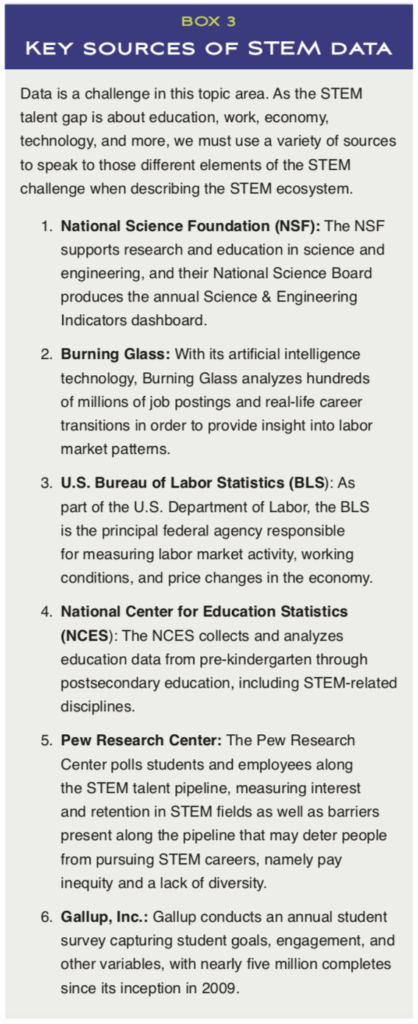STEMconnector released the State of STEM report in May of this year, and we continue to use the framework and research to drive knowledge and action for our networks. We are pleased to share a series of blog posts diving more deeply into the resources found in the call-out boxes included throughout the report.
 This second piece focuses on Box 3: Key Sources of STEM Data (page 4 of the report) and provides a brief overview of the six featured research sources. Data is used to drive decision-making by all actors in the STEM talent ecosystem, including K-12 and postsecondary educational institutions, employers, philanthropic and corporate funders, and policymakers. Much of the data available on STEM education systems focuses on programmatic outcomes such as number of students receiving an engineering degree each year, or percentage of schools offering computer science classes. From an employment perspective, data is collected at scale on single point in time counts of specific jobs such as those requiring computer science. While this data is useful, it falls short of exploring the complexity of the STEM talent ecosystem. It relies on a traditional, discipline-specific definition of STEM, and does not fully capture all the types of education and skillsets that make up the modern economy. To create a more nuanced view in State of STEM, we drew data from across disciplines and used a mix of available population-level statistics and individual educational and employer institutions’ data. Top sources include:
This second piece focuses on Box 3: Key Sources of STEM Data (page 4 of the report) and provides a brief overview of the six featured research sources. Data is used to drive decision-making by all actors in the STEM talent ecosystem, including K-12 and postsecondary educational institutions, employers, philanthropic and corporate funders, and policymakers. Much of the data available on STEM education systems focuses on programmatic outcomes such as number of students receiving an engineering degree each year, or percentage of schools offering computer science classes. From an employment perspective, data is collected at scale on single point in time counts of specific jobs such as those requiring computer science. While this data is useful, it falls short of exploring the complexity of the STEM talent ecosystem. It relies on a traditional, discipline-specific definition of STEM, and does not fully capture all the types of education and skillsets that make up the modern economy. To create a more nuanced view in State of STEM, we drew data from across disciplines and used a mix of available population-level statistics and individual educational and employer institutions’ data. Top sources include:
- Burning Glass Technologies: With its artificial intelligence tools, Burning Glass analyzes hundreds of millions of job postings and real-life career transitions in order to provide insight into labor market patterns. This nuanced data informs companies’ STEM talent acquisition strategies by recommending job descriptions reflect the types of skills available to employers, rather than focusing solely on degrees attained or the title of an open position. This broadens the pipeline for potential employees and helps identify qualified candidates.
- Gallup, Inc.: Gallup conducts an annual student survey capturing student goals, engagement, and other variables, with nearly five million completes since its inception in 2009. Understanding the profile of a student in 2018 and beyond is imperative to creating meaningful educational experiences that prepare students for post-grad success. This also informs industry in the types of applicants they can anticipate in future recruitment cycles.
- National Center for Education Statistics (NCES): The NCES collects and analyzes education data from pre-kindergarten through postsecondary education, including STEM-related disciplines. This data provides educational attainment information broken down by age, gender, and ethnicity to broaden the scope of understanding of representation in the STEM education pipeline before people even enter the workforce.
- National Science Foundation (NSF): The NSF supports research and education in science and engineering, and their National Science Board produces the annual Science & Engineering Indicators dashboard. The NSF provides data on research being funded, the future of science and engineering education, and remains a leading institution in the United States for STEM funding and programming.
- Pew Research Center: The Pew Research Center conducts secondary analysis of U.S. Census and other data, and primary surveys of students, parents, and employees, assessing interest and retention in STEM fields as well as barriers to entry and participation present along the pipeline. Recent relevant surveys include topics around attitudes among youth regarding the difficulty of STEM disciplines, and perception of discrimination and inequity in STEM workplaces based on gender and race.
- U.S. Bureau of Labor Statistics (BLS): As part of the U.S. Department of Labor, the BLS is the principal federal agency responsible for measuring labor market activity, working conditions, and price changes in the economy. This data helps students and educational institutions better understand trends in STEM jobs in order to help students understand the types of jobs available, and help educational institutions make career-readiness programs reflect the current job market.
What sources do you find most useful for understanding the STEM talent ecosystem?
Let us know here: ariana.shakibnia@STEMconnector.com OR comment box function)